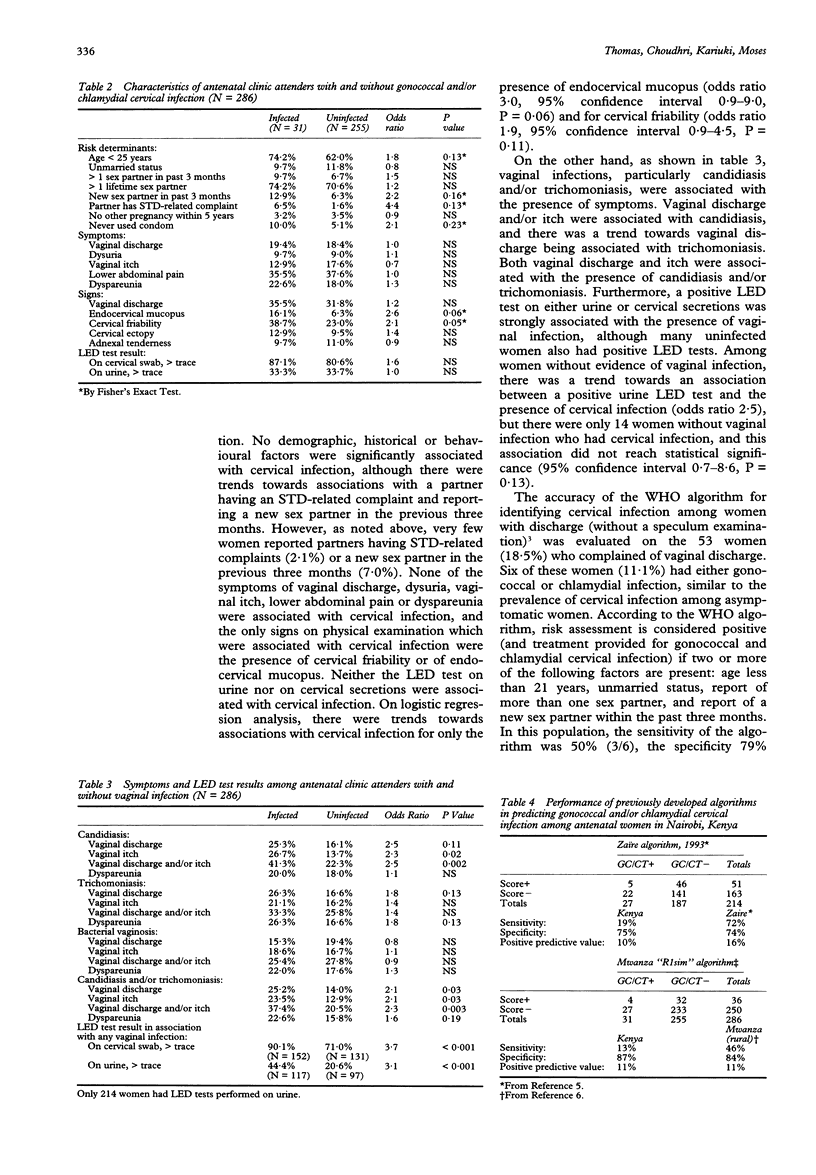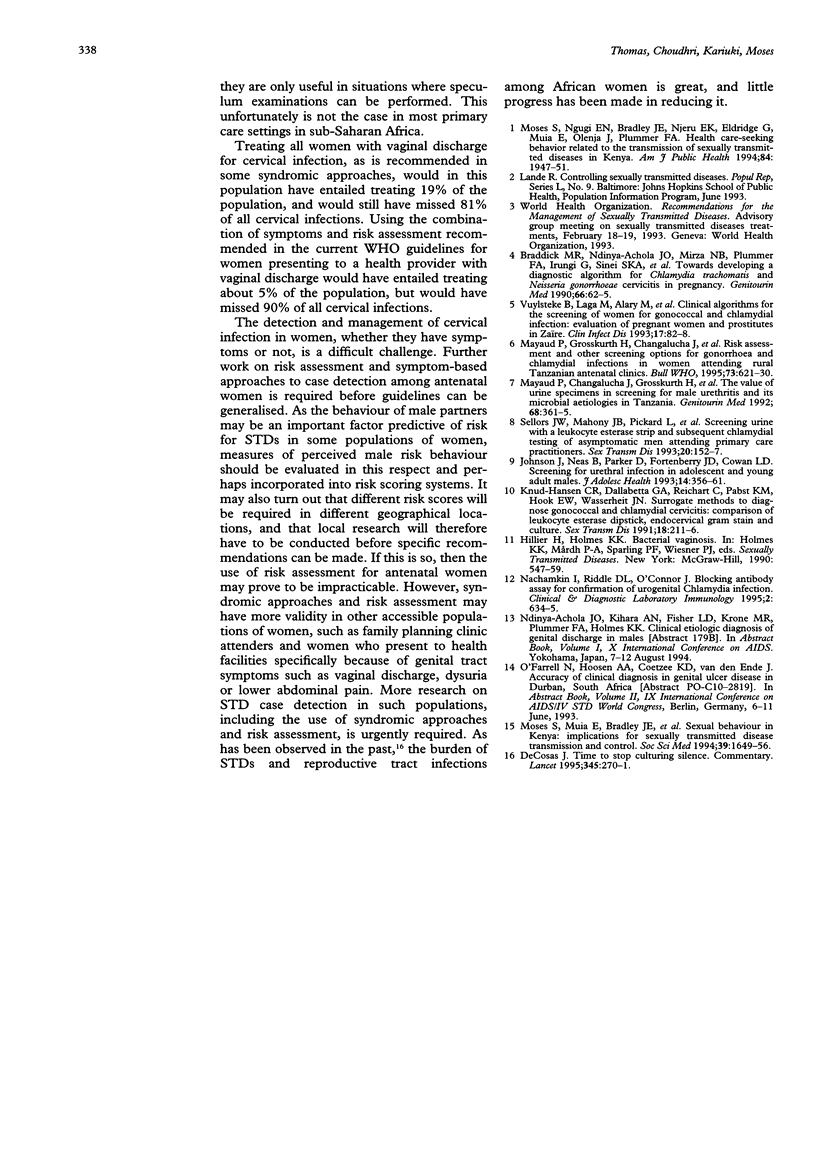Abstract
OBJECTIVES: To examine characteristics of pregnant women associated with cervical infection, and to evaluate the accuracy of symptom-based and risk assessment systems which have been developed for identifying cervical infection in antenatal women. METHODS: Interviews were conducted and physical examinations performed on 291 consecutive antenatal clinic attenders in nairobi, Kenya. Vaginal, cervical, urine and blood specimens were also obtained for analysis. RESULTS: The following disease prevalences were observed: candidiasis 26.2%; trichomoniasis 19.9%; bacterial vaginosis 20.6%; any vaginal infection 53.8%; chlamydial cervicitis (CT) 8.8%; gonococcal cervicitis (GC) 2.4%; any cervical infection 10.8%. The only statistically significant association with GC and/or CT cervical infection was the presence of cervical friability (OR = 2.1, P = 0.05). There were trends towards associations with the presence of endocervical mucopus (OR = 2.6, P = 0.06), reporting a new sex partner in the past 3 months (OR = 2.2, P = 0.16) and reporting that a sex partner had an STD-related symptom (OR = 4.4, P = 0.13). There were no associations with other demographic, behavioural or medical characteristics. Risk scores previously developed for detecting GC/CT cervicitis in developing country antenatal populations generally performed poorly. CONCLUSIONS: The prevalences of vaginal and cervical infection observed were extremely high among these "low risk" women. Owing probably to high levels of vaginal infection and to behavioural characteristics of this urban population, factors which elsewhere have been associated with cervical infection were not found to be so in this setting. Further work on symptom-based approaches and risk assessment for STD case detection in pregnant women is required before STD management recommendations can be generalised.
Full text
PDF




Selected References
These references are in PubMed. This may not be the complete list of references from this article.
- Braddick M. R., Ndinya-Achola J. O., Mirza N. B., Plummer F. A., Irungu G., Sinei S. K., Piot P. Towards developing a diagnostic algorithm for Chlamydia trachomatis and Neisseria gonorrhoeae cervicitis in pregnancy. Genitourin Med. 1990 Apr;66(2):62–65. doi: 10.1136/sti.66.2.62. [DOI] [PMC free article] [PubMed] [Google Scholar]
- Decosas J. Time to stop culturing silence. Lancet. 1995 Feb 4;345(8945):270–271. doi: 10.1016/s0140-6736(95)90270-8. [DOI] [PubMed] [Google Scholar]
- Johnson J., Neas B., Parker D. E., Fortenberry J. D., Cowan L. D. Screening for urethral infection in adolescent and young adult males. J Adolesc Health. 1993 Jul;14(5):356–361. doi: 10.1016/s1054-139x(08)80007-9. [DOI] [PubMed] [Google Scholar]
- Knud-Hansen C. R., Dallabetta G. A., Reichart C., Pabst K. M., Hook E. W., 3rd, Wasserheit J. N. Surrogate methods to diagnose gonococcal and chlamydial cervicitis: comparison of leukocyte esterase dipstick, endocervical gram stain, and culture. Sex Transm Dis. 1991 Oct-Dec;18(4):211–216. doi: 10.1097/00007435-199110000-00003. [DOI] [PubMed] [Google Scholar]
- Mayaud P., Changalucha J., Grosskurth H., Ka-Gina G., Rugemalila J., Nduba J., Newell J., Hayes R., Mabey D. The value of urine specimens in screening for male urethritis and its microbial aetiologies in Tanzania. Genitourin Med. 1992 Dec;68(6):361–365. doi: 10.1136/sti.68.6.361. [DOI] [PMC free article] [PubMed] [Google Scholar]
- Mayaud P., Grosskurth H., Changalucha J., Todd J., West B., Gabone R., Senkoro K., Rusizoka M., Laga M., Hayes R. Risk assessment and other screening options for gonorrhoea and chlamydial infections in women attending rural Tanzanian antenatal clinics. Bull World Health Organ. 1995;73(5):621–630. [PMC free article] [PubMed] [Google Scholar]
- Moses S., Muia E., Bradley J. E., Nagelkerke N. J., Ngugi E. N., Njeru E. K., Eldridge G., Olenja J., Wotton K., Plummer F. A. Sexual behaviour in Kenya: implications for sexually transmitted disease transmission and control. Soc Sci Med. 1994 Dec;39(12):1649–1656. doi: 10.1016/0277-9536(94)90079-5. [DOI] [PubMed] [Google Scholar]
- Moses S., Ngugi E. N., Bradley J. E., Njeru E. K., Eldridge G., Muia E., Olenja J., Plummer F. A. Health care-seeking behavior related to the transmission of sexually transmitted diseases in Kenya. Am J Public Health. 1994 Dec;84(12):1947–1951. doi: 10.2105/ajph.84.12.1947. [DOI] [PMC free article] [PubMed] [Google Scholar]
- Nachamkin I., Riddle D. L., O'Connor J. Blocking antibody assay for confirmation of urogenital Chlamydia infection. Clin Diagn Lab Immunol. 1995 Sep;2(5):634–635. doi: 10.1128/cdli.2.5.634-635.1995. [DOI] [PMC free article] [PubMed] [Google Scholar]
- Sellors J. W., Mahony J. B., Pickard L., Jang D., Groves D., Luinstra K. E., Chernesky M. A. Screening urine with a leukocyte esterase strip and subsequent chlamydial testing of asymptomatic men attending primary care practitioners. Sex Transm Dis. 1993 May-Jun;20(3):152–157. doi: 10.1097/00007435-199305000-00007. [DOI] [PubMed] [Google Scholar]
- Vuylsteke B., Laga M., Alary M., Gerniers M. M., Lebughe J. P., Nzila N., Behets F., Van Dyck E., Piot P. Clinical algorithms for the screening of women for gonococcal and chlamydial infection: evaluation of pregnant women and prostitutes in Zaire. Clin Infect Dis. 1993 Jul;17(1):82–88. doi: 10.1093/clinids/17.1.82. [DOI] [PubMed] [Google Scholar]


